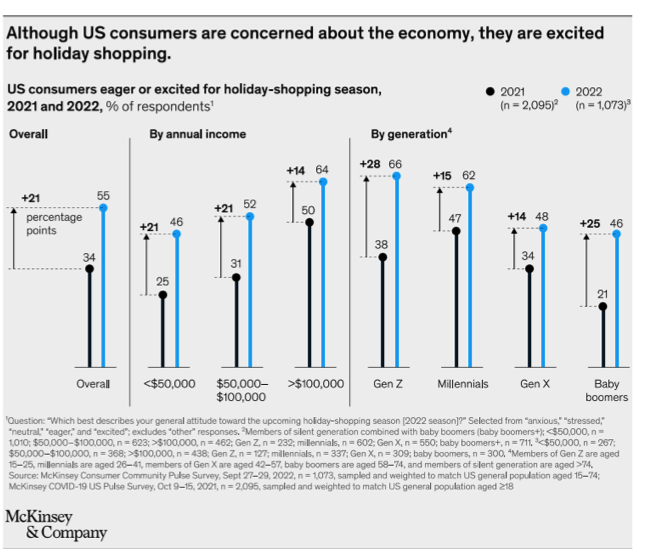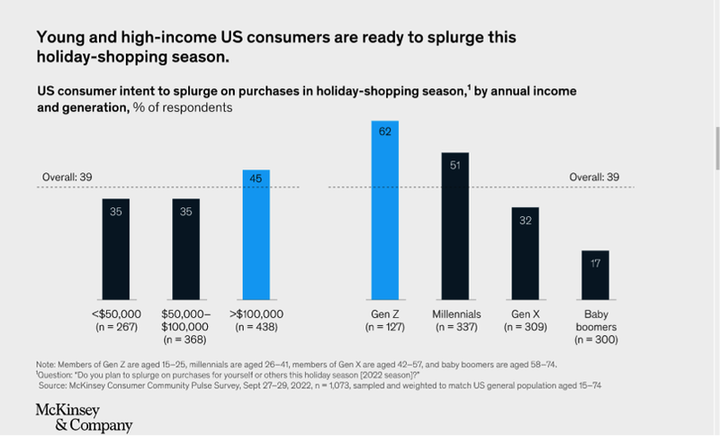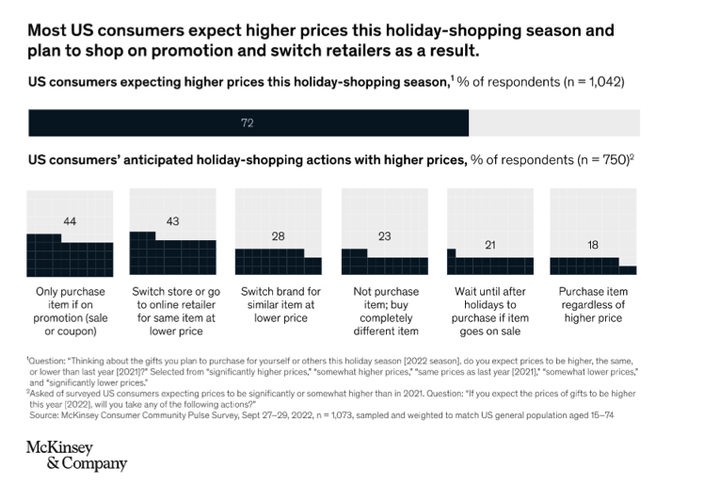

US holiday shopping 2022: ’Tis the season to be (cautiously) optimistic
The following is an excerpt from McKinsey’s latest Consumer Pulse Survey, outlining how consumers feel about holiday spending and what retailers can do to adapt to the mixed signals.
By Colleen Baum, Joyce Chai, Tamara Charm, Kelsey Robinson, and Tom Skiles.
Colleen Baum
Kelsey Robinson
Tamara Charm
Tom Skiles
Joyce Chai


Colleen is a partner in McKinsey's Retail Practice and leads our retail real estate work in North America. She helps retailers and apparel brands drive performance, and delivers expertise in brand and category strategy, store footprint and format innovation, assortment localization, merchandise planning and allocation, supply chain network planning, and omnichannel fulfillment.
Before joining McKinsey, Colleen worked as supply chain strategy manager at Home Depot, where she led a team responsible for selecting distribution center locations, managing store service assignments, and designing a multi-tier inventory positioning model. She holds a BS in industrial and systems engineering from the Georgia Institute of Technology.


Kelsey partners with executives to integrate digital into all facets of their business and marketing strategies. Drawing on extensive experience in digital marketing, customer relationship management, and customer analytics, she helps clients drive sales performance.
Since joining McKinsey, Kelsey has advised executives as they seek ways to drive overall growth and to improve the effectiveness of their marketing. Focusing on fostering strategic and sustainable business growth, she has partnered with companies in the retail, consumer tech, telecom, travel, and media sectors.
Kelsey is also a driving force behind McKinsey's partnerships with LeanIn.org and Women in the Workplace and leads McKinsey’s West Coast Gender Initiative. Kelsey co-led McKinsey’s research into fostering the success and participation of minorities and girls in STEM education. She has authored numerous articles on talent in the digital era and independent workers, published by McKinsey and other leading business media.
Before joining McKinsey, she worked at Digitas, a leading global digital advertising agency, where she led efforts focused on cross-channel digital media strategy, online advertising analytics, and tech-enabled customer targeting.


Alexandre holds a Master's degree in business law and taxation from the University of Assas, then Colombia University (USA). He completes his scholarship with a Master's degree in management at HEC (2011). Alexandre started his career as a business lawyer, specialized in mergers and acquisitions. Then he began his entrepreneurial vocation in 2014 and founded his first start-up Matchimmo, an online real estate acquisition platform. In 2016, after facing the difficulty of decorating his 1st apartment, he created nfinite (ex hubstairs).


As a leader of McKinsey's agile insights capabilities and our consumer insights hub, Tamara works with consumer-facing companies to drive brand transformation, growth, and innovation by deeply understanding consumers’ needs, beliefs, behaviors, and preferences. Her experience spans branding, marketing, and strategy decisions that can be shaped and reshaped by the changing consumer.
Tamara loves delving into the “why” by gaining insight into the motivations and preferences that drive consumer behavior. Based on her expertise, Tamara counsels clients on how to best address consumers’ needs. She brings this expertise and passion into her work and partners with organizations that are growing or innovating, as well as with private-equity companies evaluating or nurturing brands with strong consumer pull that will spur substantial growth.
Tamara authors McKinsey’s industry-leading research on consumer sentiment. She is also a frequent author on consumer insights topics and regularly speaks at industry forums. Tamara occasionally conducts in-home ethnographies and is a RIVA-trained qualitative moderator.
Before McKinsey, Tamara was involved in several not for profits and nongovernmental organizations in a professional capacity. She continues to be involved in her areas of passion as a community and board member.


Alexandre holds a Master's degree in business law and taxation from the University of Assas, then Colombia University (USA). He completes his scholarship with a Master's degree in management at HEC (2011). Alexandre started his career as a business lawyer, specialized in mergers and acquisitions. Then he began his entrepreneurial vocation in 2014 and founded his first start-up Matchimmo, an online real estate acquisition platform. In 2016, after facing the difficulty of decorating his 1st apartment, he created nfinite (ex hubstairs).
As the weather cools and the air turns crisp, US retailers are once again facing challenges for the holiday-shopping season. The past couple of years saw severe, systemic supply chain disruptions and high case rates for COVID-19. However, the landscape is more nebulous this time. Consumer demand has softened, while inventory levels are higher than they’ve been in years, and company earnings continue to face scrutiny from Wall Street as some profits decline.
Meanwhile, US consumers continue to send mixed signals. Their sentiment about the economy remains historically low, and they still have concerns about inflation. They’re looking for savings by trading down and seeking value where they can find it. But many of them have cash to spend—and they say they’re not just willing but eager to spend and splurge. People in the United States are more excited for the holidays than they’ve been in years.
With this divergent dynamic in mind, many retailers have kicked off the holiday-shopping season earlier than ever. Some retailers are doubling down on membership benefits to drive loyalty and increase their share of wallet. Others are announcing price match guarantees and widening return windows during the holidays to reach more consumers. Retailers are also making adjustments that are less visible to consumers: by using data and investing in automation to predict shopping preferences and manage inventory, or by hiring fewer seasonal employees in anticipation of slower growth.
Consumers are looking for value. Given economic uncertainty, consumers are being more surgical about how they spend. Nearly half of US survey respondents say they would switch stores if they found a better price elsewhere.
Consumer-facing companies can capitalize on US consumers’ optimism and willingness to spend during the holiday season by focusing on providing value:
- Adapt to your consumer. Not all consumers are the same, and retailers can tailor their approaches to the people they want to reach. Higher-income consumers have more to spend and are more willing to splurge on discretionary items, whereas lower-income consumers are more likely to give holiday gifts that fill a need. Given people’s propensity to delay purchases, retailers should focus on inspiring consumers with the right items at the right price and at the right time.
The findings from McKinsey’s latest Consumer Pulse Survey of more than 1,000 consumers the United States, sampled and weighted to match the general population, show that there are good reasons for US retailers to be optimistic. The following are the key discoveries:
The holidays are back. After nearly three years of suppressed behavior resulting from the COVID-19 pandemic, people are primed to go all out to celebrate for the holidays. In the survey, 55 percent of US respondents say they are excited about holiday shopping, and most people have the savings to spend.
Holiday shopping has already begun. Concerns about ongoing inflation and product availability—along with retailers’ early planning this year—have encouraged US consumers to shop earlier than ever: 56 percent have already started shopping in October instead of waiting until later in the season.



- Set earlier, wider-reaching promotions. If retailers haven’t already done so, they should kick off the holiday-shopping season now with distinctive value, differentiated promotions, and personalized offerings. US consumers are shopping already and looking for value, so building on their enthusiasm early could lead to momentum. Leveraging excess inventory to trigger the holiday spirit now can have the added benefit of clearing store space for new arrivals after Black Friday in late November. Providing unique in-store offerings and services could reach more consumers now that foot traffic is back up.
- Allow for more purchasing flexibility. By offering convenience and accessibility to value, retailers can reach more consumers and garner more loyalty. That could include employing a price match guarantee or offering flexible fulfillment options, such as in-store pickup, expedited shipping toward the end of the holiday season, and temporarily widening the window for returns.
- Maintain a long-term pulse on trade-offs. Delivering value will help retailers win this holiday-shopping season. But for long-term health, companies should also constantly consider the trade-offs between the holiday frenzy and the longer-term potential impact of any changes on brand image and overall profitability. Understanding details on customer acquisition during the holidays and deploying customer-relationship-management tactics soon after the holidays can help retailers retain loyalty.
Colleen Baum is a partner in McKinsey’s New York office; Joyce Chai is an associate partner in the Bay Area office, where Kelsey Robinson is a senior partner; Tamara Charm is a partner in the Boston office; and Tom Skiles is a capabilities and insights expert in the Chicago office.
















